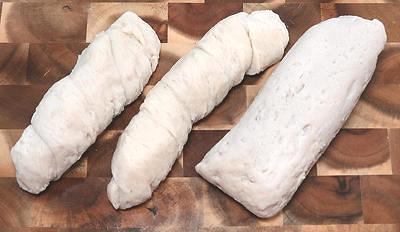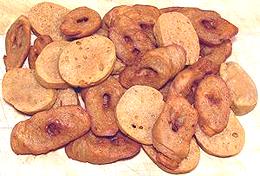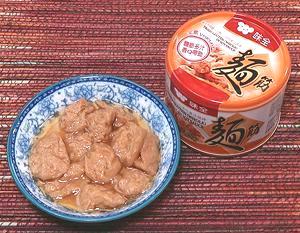 [Seitan (Japan, MK Macrobiotics); Miàn jin (Chinese); milgogi
(Korea)]
[Seitan (Japan, MK Macrobiotics); Miàn jin (Chinese); milgogi
(Korea)]
Wheat gluten is made by washing the starch out of bread flour ("strong flour" in England). This can be done at home, but various gluten products are sold canned in Asian markets, including mock duck with a duck skin texture, mock abalone and mock scallops. Most of these products are fried before canning.and need to be washed in several changes of hot water to remove the oil taste.
The Gluten Cakes shown in the photo were about 6 inches long by 0.88 inch, diameter and weighted 8 ounces average. 2020 US $0.99 each. The Gluten Rolls in the photo were about 6 inches long by 1.33 inch diameter and weighed 3.3 ounces average, 2020 US $0.59 each. Both were purchased out of tubs of water from a large Asian market in Los Angeles (San Gabriel). I have also seen rolls packaged in plastic bags sold in the refrigerated section near the tofu. The twisted roll has more texture and fries faster than the sausage, but both are suitable for most recipes. These products are fully cooked by steaming or boiling.
Wheat gluten is used in vegetarian cuisines as a replacement for meat. Does it taste like meat? Well, not really. Does it have the texture of meat? Not really, but it's as close as you're going to get. On the other hand, it's a very worthy product despite its failure to be meat. Some vegetarian purists with vivid imaginations won't eat it because it's "too meat like", but it's been truly said, "A purest will say anything to make life more difficult".
 Gluten is most often deep fried, and will achieve its most meat-like
consistency that way, it may also be boiled or steamed.
The photo to the left shows gluten rolls and cakes sliced and deep
fried. Both twisted sheet and sausage forms are included. They should be
fried in oil at around 350°F/175°C in small batches. They foam
a lot when lowered in but do not splash or splatter, so frying them in
a wok or kadhai will not make a mess. Tumble them now and then for even
frying. They are done when they have good color and have been floating
at the surface for a minute or so. Remove from the oil with a wire
spider and drain on paper towels. 12 ounces of gluten rolls will yield
about 7-1/2 ounces after frying (63%). If cooking time will be short,
brown them only lightly or they will be very stiff and chewy. They
need to be simmered in a sauce for a bit for edibility.
Gluten is most often deep fried, and will achieve its most meat-like
consistency that way, it may also be boiled or steamed.
The photo to the left shows gluten rolls and cakes sliced and deep
fried. Both twisted sheet and sausage forms are included. They should be
fried in oil at around 350°F/175°C in small batches. They foam
a lot when lowered in but do not splash or splatter, so frying them in
a wok or kadhai will not make a mess. Tumble them now and then for even
frying. They are done when they have good color and have been floating
at the surface for a minute or so. Remove from the oil with a wire
spider and drain on paper towels. 12 ounces of gluten rolls will yield
about 7-1/2 ounces after frying (63%). If cooking time will be short,
brown them only lightly or they will be very stiff and chewy. They
need to be simmered in a sauce for a bit for edibility.
 [Yóu miàn jin]
[Yóu miàn jin]
This is a common product in East Asian markets here in Los Angeles. It
is used in many Chinese recipes, particularly vegetable stews and stir
fries. The photo specimen, in a 6 ounce can (drained weight 4 ounces),
packed in a soy sauce flavored broth, was purchased from a large Asian
market in Los Angeles (San Gabriel) for 2020 US $1.29 / can. Ingred:
Water, Fried Gluten (18%)(Wheat flour, Soybean Oil), Soy Sauce (8%)
(Water, Soybean, Wheat, Salt), Sugar, Salt.
 This is just Wheat Gluten like any other. It was introduced to North
Americans by the Michio Kushi Macrobiotics movement under the name
"seitan". This name is said to have been made up by movement founder
George Ohsawa, and originally used in Japan. From there it spread to
the general vegetarian communities and is used to make various meat
substitutes, including Tofurkey.
This is just Wheat Gluten like any other. It was introduced to North
Americans by the Michio Kushi Macrobiotics movement under the name
"seitan". This name is said to have been made up by movement founder
George Ohsawa, and originally used in Japan. From there it spread to
the general vegetarian communities and is used to make various meat
substitutes, including Tofurkey.
The photo shows deep fried SeitanPuffs - the same thing as the canned ones above, but much larger and with no sauce. They were about 2-1/2 inches across and weighed nearly an ounce each. They were tough and chewey, needing a simmer in some kind of sauce to be really edible. Ingred: water, vital wheat gluten, canola oil, baking powder.
Seitan is often sold by outlets serving Macrobiotics and vegetarian communities, usually in block form. It is also sold in powdered form, called "Vital Wheat Gluten" to be reconstituted with water. This form saves the trouble of washing the starch out by hand when you need fresh wheat gluten. Caution: Inhaling the powder presents risk of gumming up the lungs - wear a face mask when handling.